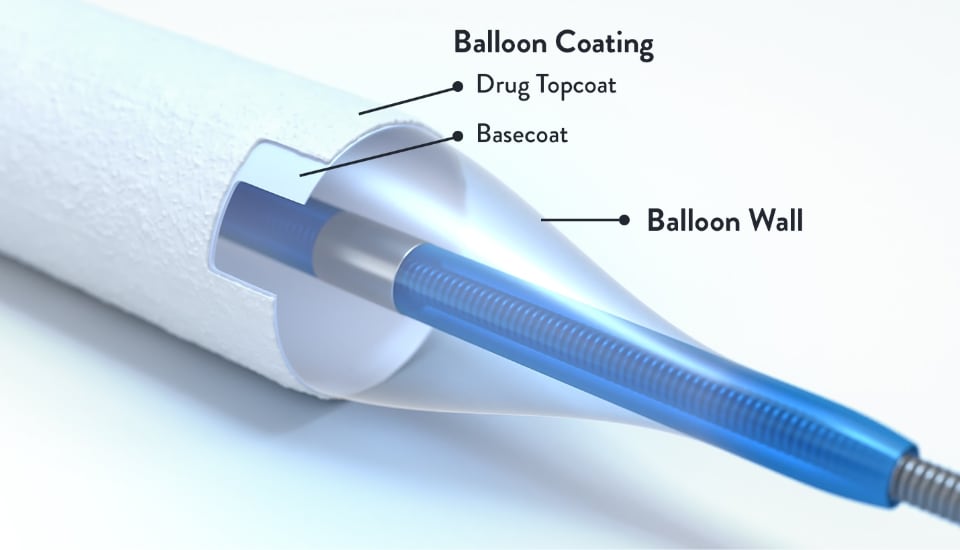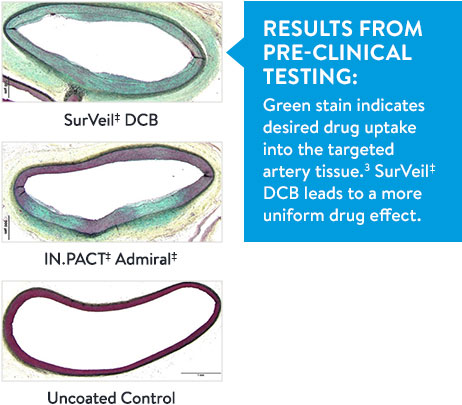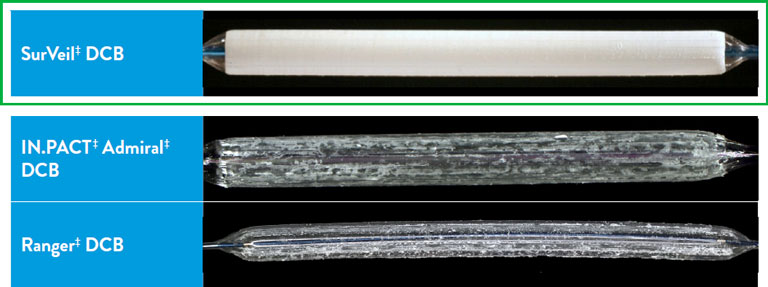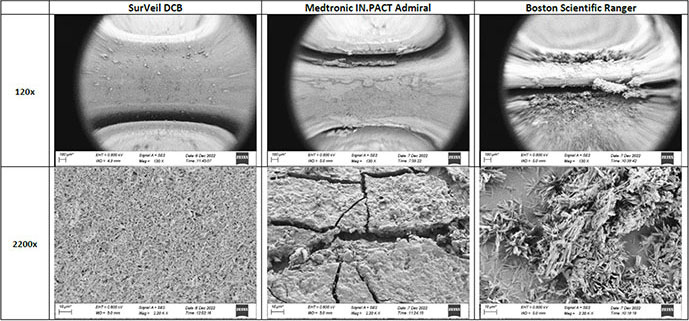SurVeil‡ Drug Coated Device Features1
The SurVeil‡ DCB is a standard 0.035” over-the-wire (OTW) PTA catheter, with a 135 cm usable catheter length and a semi-compliant balloon at the distal tip.
Next Generation DCB Design
The drug coating of the SurVeil DCB consists of paclitaxel (active pharmaceutical ingredient) and polyethyleneimine (excipient). The drug coating is uniformly distributed across the balloon surface at a nominal paclitaxel dose density of 2.0 μg/mm². The polycationic polymer polyethyleneimine is used as an excipient to facilitate delivery and efficient transfer of the paclitaxel from the balloon to the vessel wall upon balloon expansion.1

Circumferential Drug Distribution
SurVeil‡ DCB delivered an efficient transfer of five times more drug to the target artery tissue than the IN.PACT‡ Admiral‡ DCB in pre-clinical setting.2 The homogeneous microcrystalline paclitaxel crystals led to an efficient circumferential transfer and uptake of the drug as measured in the treated artery 24 hours after use, as demonstrated in pre-clinical testing.2
SurVeil‡ DCB provided sustained drug tissue concentration through 180 days in pre-clinical testing.4 The balloon excipient polyethyleneimine (PEI) allows for uniform, targeted transfer and retention of microcrystalline paclitaxel to the vessel wall.1

Check the Submerge and Deploy video. Devices are submerged in water, inflated unconstrained to nominal pressure, then removed from the model to visually compare particulates generated by each device type.5
Uniform Drug Coating consistency and uniformity varies amongst DCBs5
Comparison to Benchmark DCBs
Balloons dry expanded to nominal pressure

Scanning Electron Microscope (SEM) Images From the DCBs Drug Coating at 120x and 2200x5

References
- SurVeil‡ Drug-Coated Balloon (DCB) U.S. Instructions for Use (IFU). Refer to IFU for additional information.
- Results from a 28-day porcine study. Pre-clinical results may not be indicative of clinical performance. Different test methods may yield different results. Data on file at Abbott.
- Porcine iliofemoral arteries at 28 days post treatment.
- Results from a 365 days GLP porcine study. Pre-clinical results may not be indicative of clinical performance. Different test methods may yield different results. Data on file at Abbott.
- Data on file at Abbott.
MAT-2311764 v1.0
Important Safety Information
SurVeil‡ Drug-Coated
Balloon (DCB)

Indications
The SurVeil‡ DCB is indicated for percutaneous transluminal angioplasty, after appropriate vessel preparation, of de novo or restenotic lesions (≤ 180 mm in length) in femoral and popliteal arteries having reference vessel diameters of 4 mm to 7 mm.
Contraindications
The SurVeil‡ DCB is contraindicated for use in:
- Patients who cannot receive recommended antiplatelet and/or anticoagulant therapy
- Patients with known hypersensitivity to paclitaxel or structurally related compounds
- Patients judged to have a lesion that prevents complete inflation of an angioplasty balloon or proper placement of the delivery system
- Women who are breastfeeding, pregnant or are intending to become pregnant or men intending to father children
- Coronary, renal and supra-aortic/cerebrovascular arteries
Warnings
- Adhere to the following use parameters for the index procedure:
- Do not use more balloons than necessary. No more than 200 mm of total balloon length should be used, for a total maximum treatable length of 180 mm.
- This product should not be used bilaterally or in multiple lesions that cannot be treated with up to 200 mm total balloon length.
- The safety of exposure to higher doses of the paclitaxel/polyethyleneimine (PEI) drug coating has not been established.
- The SurVeil‡ DCB is supplied STERILE for SINGLE USE ONLY. Do not reuse and/or resterilize.
- Do not open sterile package until you are ready to begin the procedure.
- Do not use if the integrity of the sterile package has been compromised or if any sterile package or product defects are noted.
- Do not use after the Use by Date on the label.
- Do not exceed the rated burst pressure (RBP) recommended in the compliance chart for this device specified on device packaging.
- To minimize the potential for vessel damage, ensure the expected inflated diameter of the balloon approximates the intended treatment segment.
- Do not use any gaseous medium to inflate the balloon.
- Do not use device if air does not aspirate properly.
- Completely deflate the balloon and maintain negative pressure before withdrawing it from the dilated area.
- The safety and effectiveness of utilizing multiple SurVeil‡ DCBs with a total drug dosage exceeding 9048 μg of paclitaxel in a patient has not been clinically evaluated in the TRANSCEND trial.
DO NOT REUSE and/or RESTERILIZE the SurVeil‡ DCB. Reuse and/or resterilization may create a risk of contamination of the device and/or cause patient infection or cross-infection, including, but not limited to, the transmission of infectious disease(s). Contamination of the device may lead to injury, illness, or death of the patient. Reuse and/or resterilization may compromise integrity of the device, including the drug coating, or lead to device failure, which may result in patient injury, illness, or death. Surmodics is not responsible for any direct, incidental, or consequential damages resulting from reuse and/or resterilization.
Precautions
- The SurVeil‡ DCB is only to be used by clinicians trained in peripheral vascular percutaneous interventional procedures. A thorough understanding of the technical principles, clinical applications and risks associated with percutaneous transluminal angioplasty is necessary before using the SurVeil‡ DCB.
- Consideration should be given to the risks and benefits of use in patients with a history of non-controllable allergies to contrast solution.
- Use only the recommended balloon inflation solution (50% contrast / 50% sterile saline).
- Administer appropriate drug therapy to the patient according to standard protocols for PTA before insertion of the dilatation catheter.
- Take precautions to prevent or reduce clotting when any catheter is used. Flush and rinse all products entering the vascular system with heparinized normal saline or a similar solution. For the SurVeil‡ DCB, flush the guidewire lumen through the guidewire port with heparinized normal saline until the fluid exits the distal tip. Do not rinse or wipe the SurVeil‡ DCB.
- Keep the SurVeil‡ DCB dry prior to insertion into the body. Replace any device that has come into contact with fluids prior to use.
- Do not immerse the SurVeil‡ DCB in a saline bath.
- Handle the SurVeil‡ DCB only with dry sterile gloves.
- Avoid moisture contact with the balloon.
- Minimize contact with the coated balloon. Extended manipulation of the SurVeil‡ DCB can cause loss of coating integrity.
- Keep the balloon sheath in place during preparation of the SurVeil‡ DCB. Remove the balloon sheath immediately before placing over guidewire.
- If difficulty is encountered while removing the balloon sheath, discard device and use a new SurVeil‡ DCB.
- Do not attempt to pass the SurVeil‡ DCB through an introducer that is smaller than indicated in the list of required materials or on the primary package label.
- Do not inflate the balloon outside the body or prior to reaching the target segment as it may disrupt the drug coating.
- Always advance and withdraw the SurVeil‡ DCB under negative pressure.
- Do not use the SurVeil‡ DCB if the shaft has been bent or kinked because device function could be compromised.
- Do not advance the SurVeil‡ DCB if resistance is met.
- Do not move the guidewire or reposition once inflation has begun.
- Only change the position of the balloon catheter with the guidewire in place.
- Do not over-tighten the hemostatic valve around the SurVeil‡ DCB as lumen constriction may occur, affecting inflation/deflation of the balloon. Advance the SurVeil‡ DCB to the target segment in an efficient manner and immediately inflate.
- To prevent over-pressurization, use a pressure monitoring device.
- Minimize the number of contrast solution injections during positioning to ensure appropriate drug delivery to lesion.
- Use of the SurVeil‡ DCB in conjunction with other drug-eluting stents or drug-coated balloons in the same procedure or following treatment failure has not been evaluated.
Pre- and post-procedure medication regimen
It is strongly advised that the treating physician follow the Inter- Society Consensus (TASC II) Guidelines recommendations (or other applicable country guidelines) for antiplatelet therapy pre- and post-procedure
Potential Adverse Events
Potential adverse events, which may be associated with the use of a peripheral-dilatation balloon catheter procedure may include, but are not limited to, the following:
- Acute re-occlusion necessitating surgical intervention
- Allergic reaction to contrast solution, anti-platelet therapy, or catheter system components
- Amputation
- Aneurysm
- Arrhythmias
- Arterio-venous fistula
- Bleeding
- Death
- Endocarditis
- Femoral nerve compression with associated neuropathy
- Groin area bruising and discomfort
- Ischemia or infarction of tissue/organ
- Renal insufficiency or failure
- Local hematoma
- Local hemorrhage
- Local infections
- Local or distal thromboembolic episodes
- Low blood pressure
- Pain and tenderness
- Pseudoaneurysm
- Pyrogenic reaction
- Respiratory failure
- Restenosis of the dilated artery
- Sepsis/infection
- Short-term hemodynamic deterioration
- Stroke
- Systemic embolization
- Total occlusion or thrombosis
- Vessel damage, dissection, perforation, rupture, or spasm
Potential adverse events that may be unique to the paclitaxel drug coating may include, but are not limited to:
- Allergic/immunologic reaction
- Alopecia
- Anemia
- Gastrointestinal symptoms
- Hematologic dyscrasia (including leukopenia, neutropenia, thrombocytopenia)
- Hepatic enzyme changes
- Histologic changes in vessel wall, including inflammation, cellular damage, or necrosis
- Myalgia/arthralgia
- Myelosuppression
- Peripheral neuropathy
SurVeil‡ is manufactured by Surmodics, Inc., distributed by Abbott Group of Companies
MAT-2213996 v1.0
